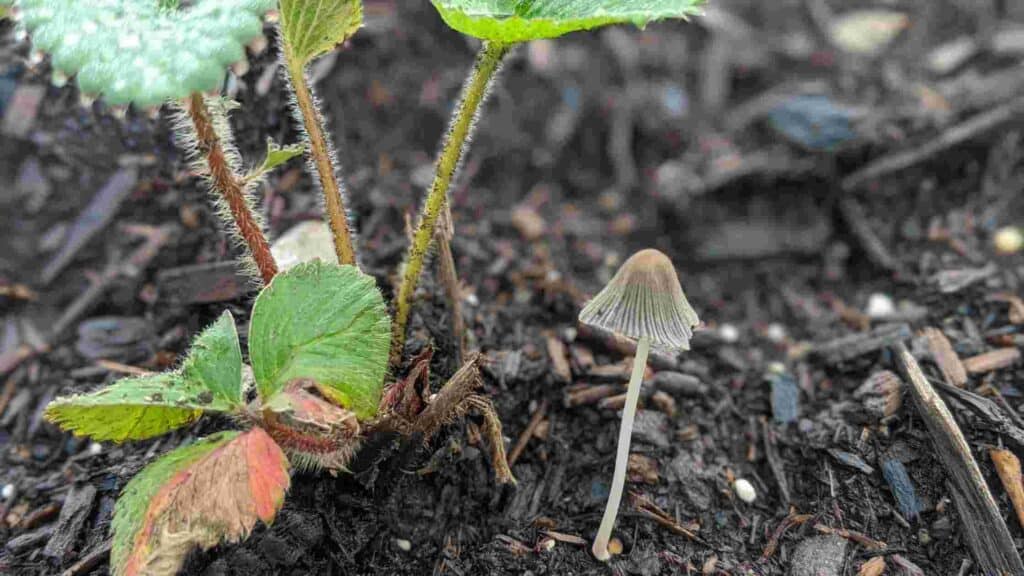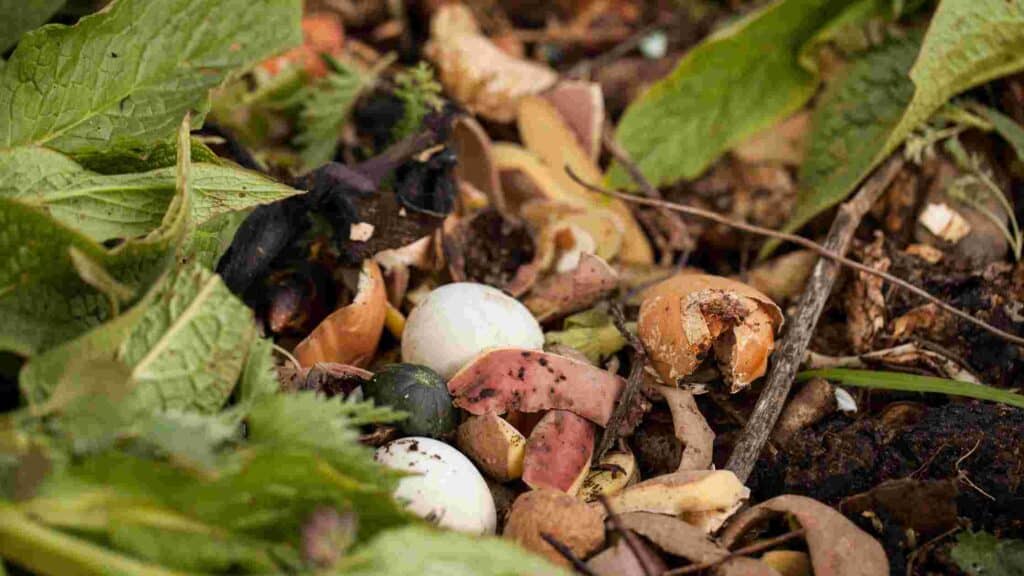Are those mushrooms popping up in your mulch, making your garden look unattractive? Well, you’re not alone! Let’s dive into some gardening know-how and tips for how to get rid of mushrooms in mulch!
How To Get Rid Of Mushrooms In Mulch
Many gardeners face this common problem, and it’s time to take charge and remove those fungi from your garden for good. Not only do they spoil the aesthetics, but they can also pose a risk to your pets and little ones if ingested.
Will Vinegar Kill Mushrooms In Mulch?
If you’re looking for a natural solution to kill those mushrooms, vinegar is a great option. This solution not only kills the fungi but also keeps them from coming back to your mulch again.
Here’s how to do it:
Step 1 – Mix the Solution
Grab a spray bottle and dilute one-part white vinegar with four parts water.
Step 2 – Apply It On The Mushrooms
Give them a good spray with your vinegar solution. Don’t forget to shield your eyes with protective glasses. Keep the spray about 4 to 6 inches away from the mushrooms. Also, avoid the grass and other plants in the process.
Step 3 – Monitor The Garden
Let the vinegar do its work for about 3 to 4 days. Then, check on your mushrooms. If any ones are still standing tall, give them another spray-down.
Keep monitoring until you’ve gotten rid of them all. Once they are dead, remove them from the mulch.
What Does It Mean When Mushrooms Grow In Your Mulch?

You might be wondering why these mushrooms keep showing up in your mulch.
Well, here’s the deal – mushrooms love to feast on decomposing organic compost. And after rain and moisture in your garden bed, it becomes a perfect stomping ground for these fungi to show up.
Now, having mushrooms in your garden isn’t all that bad; in fact, it’s a sign of healthy soil. But we get it – you want your garden to look fabulous without any surprise guests!
How Do You Get Rid Of Mulch Fungus Naturally?
Now that you’ve dealt with those mushrooms, let’s make sure they don’t come back. Here are some handy tips to keep your mulch mushroom-free:
1. Tree Trimming
If your garden beds are under the shade of towering trees, it might be time for some tree trimming work. Let some sunlight in, as mushrooms like shady spots. Proper sunlight helps the moisture dry out, and that deters mushroom growth.
2. Garden Raking
Mushrooms love a wet and moist environment. Take charge by grabbing your rake and mixing up that mulch. Loosen it up and let it dry out a bit. This will make it less inviting for those fungi to return.
3. Clear Fungus-Infested Mulch
One of the primary reasons for mushroom growth is deteriorating vegetation in your mulch.
To get rid of these unwanted mushrooms, start by removing the affected mulch using a spade or garden fork. Replace it with fresh new mulch, and use a rake to mix it through.
If there are only a few mushrooms present, you can add the affected mulch to your compost pile. Once it decomposes, you can use it later to enrich your garden soil.
4. Manual Extraction
For those occasional mushrooms that pop up, you can put on your gardening gloves and remove them by hand.
But if you’re dealing with a large section of mushrooms, it’s best to remove the affected mulch entirely to stop them from spreading (read more on how to get rid of backyard mushrooms).
5. Mulch Treatment
If you’d rather not remove the mulch entirely, you can try treating it with lime. Adding lime to the soil won’t eradicate mushrooms, but it will slow down their growth and make the soil more acidic.
This option can be beneficial for certain plants like hydrangeas, which thrive in acidic soil conditions.
Should You Remove Mushrooms From Mulch?
Sometimes, despite your best efforts, mushrooms keep popping up. In such cases, you can embrace their presence and even turn them into a charming addition to your garden.
Create a “fairy” garden with gnomes, toadstools, or ceramic mushrooms to add a whimsical touch to your yard.
Remember that mushrooms play a vital role in breaking down organic matter and enriching the soil with nutrients, which ultimately benefit the health of your plants.
How To Make Mushroom Compost

If you want to put those mushrooms to good use, consider making mushroom compost for your garden. It’s a great way to recycle organic materials and nourish your plants for better growth.
Let’s go through the step-by-step process of creating mushroom compost:
1. Blend Compostable Materials
Mushrooms alone aren’t enough to create enriching compost.
To make mushroom compost, you’ll need to mix them with other compostable materials like leaves, newspaper, wood shavings, cardboard, straw, hay, grass clippings, kitchen scraps, and manure.
However, avoid using processed foods, greases, and meats in your kitchen scraps. Stick to fruits and veggies to maintain a healthy compost mix.
When it comes to manure, choose sources like llamas, horses, or, cows, and steer clear of pet waste like cats or dogs.
2. Moisten Your Compost Pile
To start, gather all your compostable materials in a bin. Once you have everything ready, it’s time to wet the pile using a garden hose.
Be careful not to go overboard; you want the compost to feel like a damp sponge, not a waterlogged mess.
Keep in mind that you’ll need to water the compost pile regularly, but don’t overdo it; too much water can lead to rot instead of composting. The ideal state is a damp and warm pile, not water-soaked and soggy.
If you’re new to composting and want to keep an eye on progress, consider using a thermometer. The center of the pile should reach temperatures between 130 to 150 degrees Fahrenheit.
3. Weekly Compost Pile Turning
Once your compost pile reaches that optimal internal temperature, it’s time for some action. Grab a pitchfork or shovel and give the pile a good toss at least once a week.
Turning the compost helps oxygen circulate throughout the pile, which aids in the composting process. It also prevents materials from getting squished together, avoiding unpleasant odors or premature rotting.
4. Ready-To-Use Mushroom Compost
You’ll know your mushroom compost is ready in your garden when it stops feeling warm and becomes crumbly and dry. At this point, it should have an overall brown color, closely resembling the commercially bought compost.
Now, it’s time to fertilize your garden! Make sure to apply the compost in a layer of about an inch or so in thickness. This way, your plants will receive the necessary nutrients without any waste.
FAQs
1. Are mushrooms growing in mulch bad for dogs?
Yes, some mushrooms in mulch are harmful to dogs. Certain species of mushrooms can be toxic and lead to serious health issues if ingested by dogs.
To keep your furry friends safe, it’s essential to promptly remove any mushrooms you spot in the mulch and to monitor your dog’s behavior closely when they are outdoors.
2. What kind of mushrooms are growing in my mulch?
Determining the specific type of mushrooms growing in your mulch requires expertise. The best course of action is to consult a mycologist, a mushroom expert, for proper identification.
It’s crucial to avoid consuming or touching wild mushrooms without proper identification, as some can be poisonous or harmful.
3. Can there be psychedelic mushrooms in mulch?
While it’s not common, there is a possibility that psychedelic mushrooms could grow in mulch. Psychedelic mushrooms contain hallucinogenic compounds, and their presence in mulch would be a rare occurrence.
If you suspect any unusual mushrooms, it’s best to err on the side of caution and seek expert advice for identification.
4. How to get rid of mushrooms in flower bed?
To eliminate mushrooms in the flower bed, manual removal is the most effective method. Use gloves to pick them up and dispose of them properly.
Additionally, improve the flower bed’s drainage to discourage mushroom growth, as they thrive in moist environments. Regularly remove decaying organic matter from the bed to reduce mushroom colonization.
5. Are mushrooms in mulch poisonous?
Some mushrooms that grow in mulch can indeed be poisonous. As there are various species of mushrooms, it’s challenging to identify them without proper expertise.
To ensure safety, it’s best to avoid touching or consuming any wild mushrooms in the mulch and seek professional guidance for identification when in doubt.
Conclusion: How To Get Rid Of Fungus In Mulch
Dealing with unsightly lawn mushrooms in your mulch doesn’t have to be a headache. Just remember to monitor your water usage and follow these simple suggestions.
Whether you choose to replace, kill, or embrace a few mushrooms as garden features, composting can play a vital role in keeping your garden healthy and thriving.
So, let’s get composting and transform those mushrooms into a powerhouse of nutrients for your beloved garden! Happy gardening!
